Sanding And Refinishing Final
Floor sanding and floor refinishing is a process of restoring the beauty and functionality of hardwood floors by removing the top layer of wood and applying a new finish. This rejuvenates the appearance and can also help repair minor damage such as scratches and stains.
Sanding and refinishing hardwood floors serve as a practical and versatile solution to address the wear and tear that hardwood surfaces can experience over time. Whether motivated by aesthetic preferences, maintenance needs, sustainability concerns, or cost considerations, refinishing wood floors is a popular choice for homeowners looking to enhance the beauty, functionality, and value of their homes.
Primary Reasons for floor refinishing

- Restoration of Aesthetic Appeal: One of the primary motivations for refinishing wood floors is to restore their aesthetic appeal. Over time, hardwood floors can become worn, scratched, discolored, or damaged. Sanding and refinishing can transform tired and dull-looking floors into beautiful, vibrant surfaces that enhance the overall appearance of a space. It’s a cost-effective way to breathe new life into an old floor.
- 2. Repair and Maintenance: Wood floors are durable, but they’re not impervious to damage. Scratches, dents, and stains can accumulate, making the floor look worn and tired. Sanding allows for the removal of these imperfections, while refinishing seals the wood, providing a protective layer that can prevent future damage. This process can extend the life of the floor and reduce the need for costly replacements.
- 3. Enhanced Property Value: Refinishing wood floors is an investment that can significantly boost the value of a home. Well-maintained, gleaming wood floors are a highly desirable feature for homebuyers. They add a touch of luxury and can set a property apart from the competition in the real estate market.
- 4. Customization: Homeowners often choose to refinish their wood floors to change the appearance. This can be achieved by staining the wood with different colors or finishes, allowing for customization to match evolving interior design preferences. The ability to personalize the look of your floors is a major advantage of the refinishing process.
- 5. Sustainability: In an era when sustainability is a significant concern, refinishing wood floors is an eco-friendly option. Rather than replacing the entire floor, which requires the use of new materials and contributes to landfill waste, refinishing reuses the existing wood. This minimizes environmental impact while promoting sustainability.
- 6. Improved Indoor Air Quality: Older wood floors with worn-out finishes can harbor allergens, dust, and other particles that affect indoor air quality. Refinishing the floors seals the wood, making it easier to clean and maintain. This can lead to better air quality and a healthier living environment.
- 7. Cost-Effective: Replacing hardwood floors is a costly endeavor, involving not just the cost of new materials but also the labor required for installation. Sanding and refinishing, on the other hand, are typically more budget-friendly, especially when you consider the long-term benefits of extending the life of your existing floors.
- 8. Preservation of Historical Charm: In older homes, original wood floors may be a key architectural feature that adds character and charm. Rather than covering them with carpet or replacing them with modern materials, homeowners often choose to sand and refinish these floors to preserve their historical and aesthetic value.
- 9. Versatility: Wood floors are versatile and adaptable to various interior styles. Refinishing can help these floors adapt to changing décor trends, ensuring that they remain a stylish and timeless choice for flooring.
- 10. Personal Satisfaction: Many homeowners take pride in do-it-yourself (DIY) projects. Sanding and refinishing wood floors offer a sense of accomplishment and satisfaction. It allows homeowners to take an active role in home improvement, showcasing their personal touch and creativity.
How to sand and refinish hardwood floor
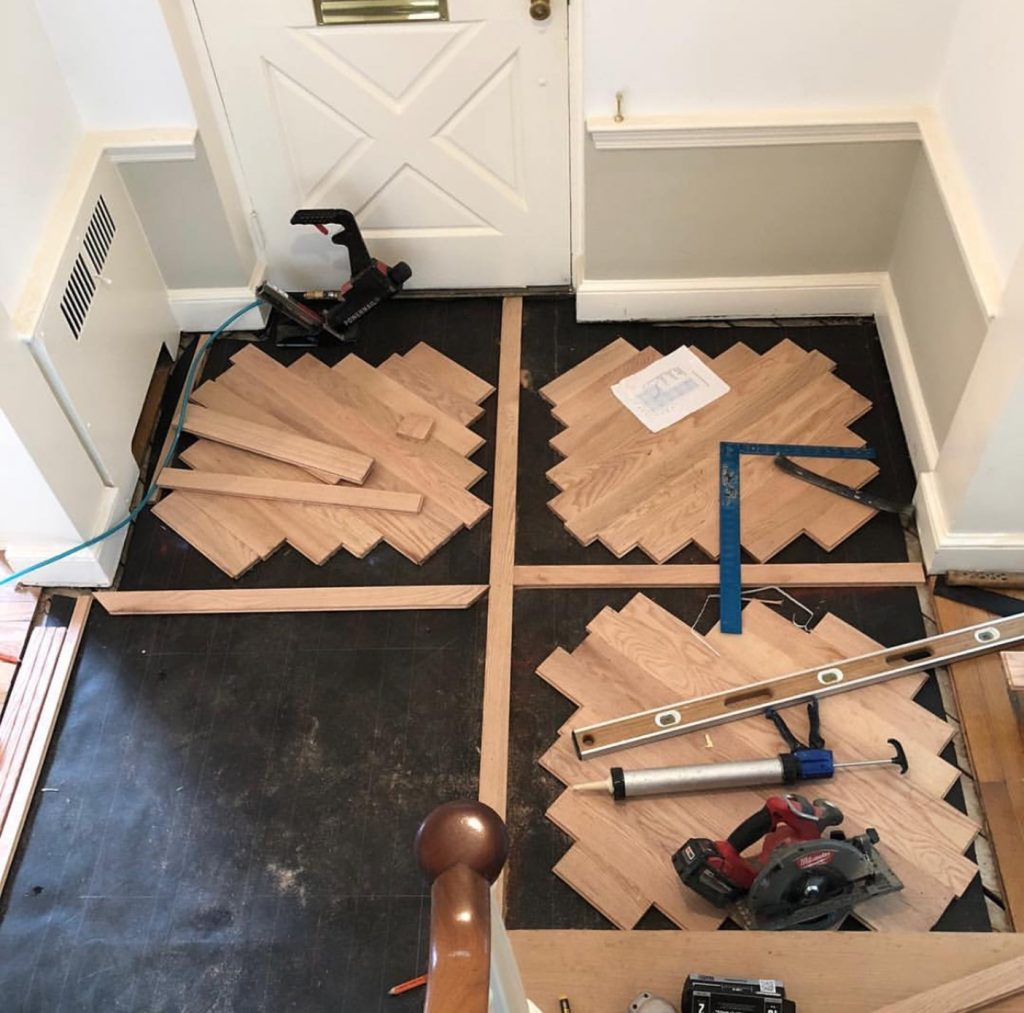
- 1. Assessment: Have a professional assess the condition of the wood floors to determine the type of wood, thickness, and any existing finish. This determines the appropriate sanding equipment and finishing products.
- 2. Preparation: Clear the room of furniture and ensure the floor is clean and free of debris. Cover vents and openings to minimize dust spreading throughout the house.
- 3. Sanding hardwood floors: Sanding hardwood floors is the most critical step in floor refinishing. It involves using a floor sander to remove the old finish and expose the bare wood. Begin with a coarse-grit sandpaper to strip the old finish, and progressively move to finer grits for a smoother surface. Always sand in the direction of the wood grain to avoid scratches. Edges and corners may require a smaller, hand-held sander.
- 4. Inspection: After sanding, thoroughly inspect the floor for imperfections. If there are deep scratches or stains that haven’t been removed, you may need to do targeted sanding or use wood filler to address them.
- 5. Vacuum and Clean: Vacuum the floor to remove dust and then wipe it down with a damp cloth to ensure it’s completely clean.
- 6. Staining (optional): If you desire a different color or want to match the existing floor, you can apply a wood stain at this stage. Follow manufacturer instructions and allow it to dry completely before moving on.
- 7. Finishing: The finishing step involves applying a protective sealant to the wood. You can choose between oil-based or water-based polyurethane finishes. Water-based finishes are more eco-friendly and dry faster, while oil-based finishes offer a deeper, amber-colored appearance. Each coat must dry as per the manufacturer’s recommendations, lightly sanding between coats for a smooth finish.
- 8. Curing: Once the final coat is applied and dried, allow the floor to cure. This can take several days to a few weeks, depending on the type of finish you’ve chosen. Avoid heavy traffic during this time to prevent damage to the finish.
- 9. Furniture: After the floors have completely cured, you can reinstall furniture and accessories. Be cautious when moving heavy items, and use protective pads under furniture legs to prevent scratches.
- 10. Maintenance: To keep your newly refinished wood floors looking their best, implement a regular cleaning and maintenance routine. Sweep or vacuum regularly to remove dirt and debris. Use a damp mop or hardwood floor cleaner designed for your specific finish. Avoid excessive water, as it can damage the wood.
Overview by Stain
Refinishing a wood floor involves not only sanding and sealing but also choosing the right stain and style to achieve the desired look. The most popular hardwood floor stain colors and styles can vary depending on current design trends, regional preferences, and personal choices.
Staining hardwood floors

Natural/No Stain: One of the most timeless and enduring choices is to leave the wood in its natural state. This allows the wood’s inherent beauty to shine through, showcasing the unique grain patterns and color variations. Natural wood floors work well with a variety of design styles and are popular for their warm, classic look.
Golden oak hardwood floor stain: A light, Golden oak stain wood stain is a classic choice. It adds warmth and a touch of brightness to a room, making it feel more open and inviting. Golden oak hardwood floor stains are often selected for traditional and rustic interiors, as well as for homes with a lighter color palette.
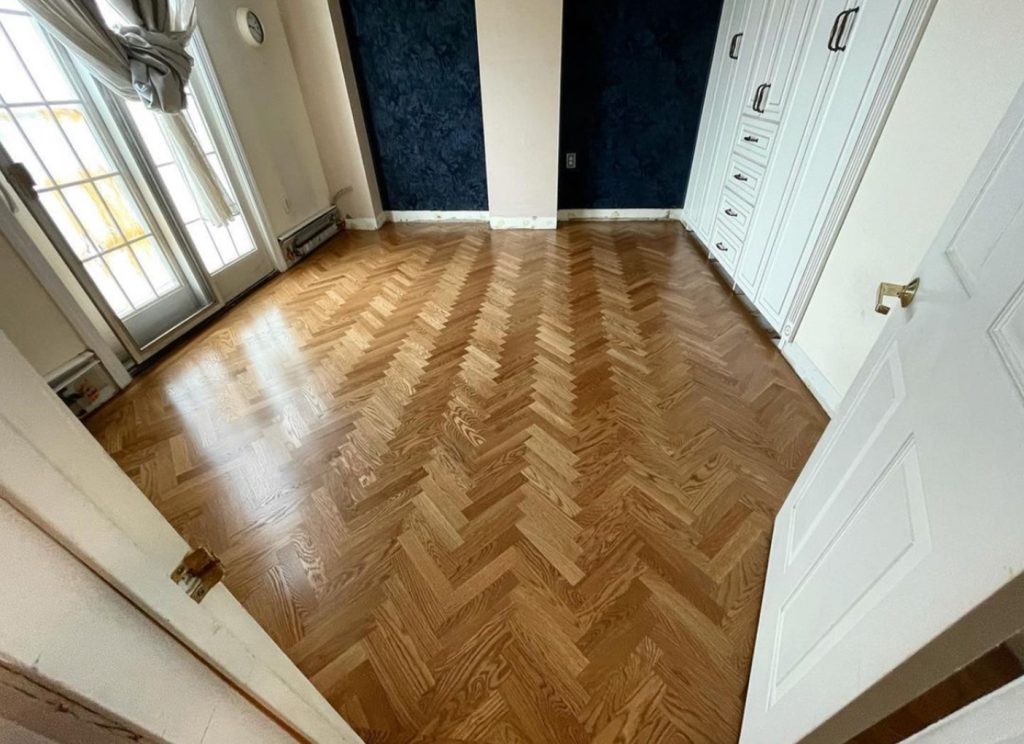

Honey and Amber Tones: Stains in honey and amber hues create a rich, warm ambiance. They add depth and character to the wood without darkening the space too much. These tones are versatile and complement a wide range of interior design styles, from traditional to contemporary.
Dark Walnut: Dark walnut hardwood floor stain are a popular choice for those who prefer a more dramatic, modern, or elegant look. They create deep, rich, brown tones and work well in contemporary and upscale settings. However, it’s important to note that dark stains can make spaces appear smaller and may require more maintenance to hide scratches and wear.
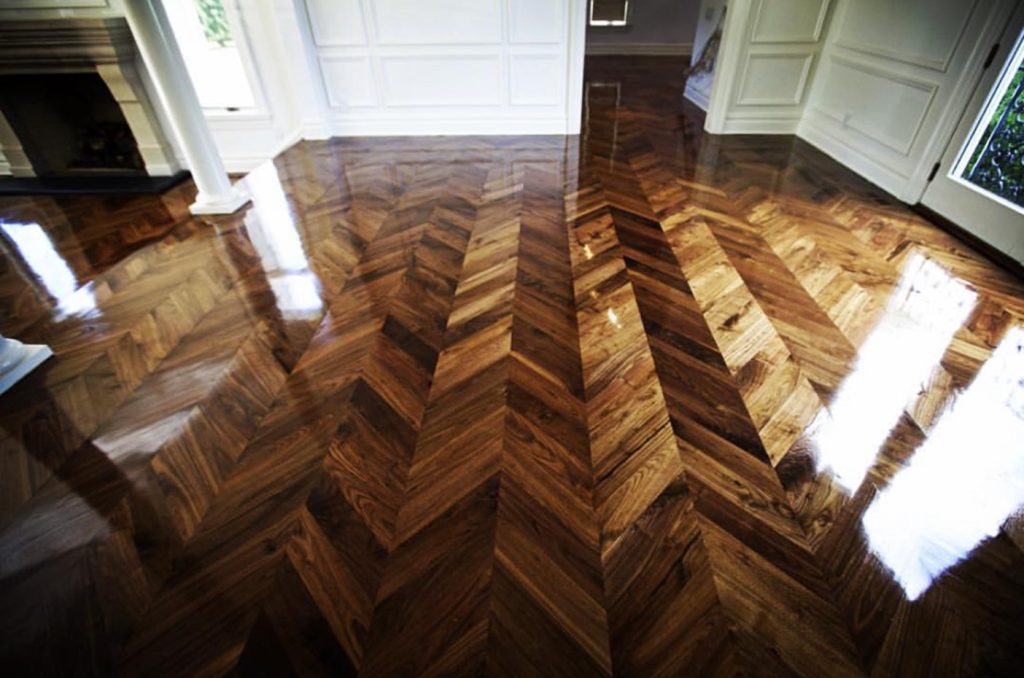

Espresso and Jacobean: These dark, nearly black stains create a bold and sophisticated atmosphere. They are often used in modern and minimalist interiors, providing a sleek and sleek look. However, dark stains can show dust and scratches more readily.
Gray and Driftwood: Gray and driftwood hardwood floor stains are trendy choices, particularly in contemporary and coastal-style interiors. These stains create a weathered, beachy look and pair well with white or light-colored furniture and décor. They also help to mask small imperfections in the wood.


Whitewash and Pickled: Whitewash and pickled stains offer a light, airy, and vintage appearance. They are excellent for achieving a shabby-chic, cottage, or Scandinavian design style. These stains work well for creating a bright, open feel in spaces with limited natural light.
Mixed and Custom Stains: Some homeowners prefer unique, custom stain combinations. These can include layering different stains or custom-mixing to achieve a one-of-a-kind look. Custom staining allows for creative expression and personalization to match specific design preferences.

Overview by Style
The choice of stain and style for hardwood floor refinishing is a highly personal decision. It's essential to consider your design preferences, the room's lighting, and the existing decor when making this decision. Popular stains and styles range from classic and timeless to modern and trendy, allowing you to create the perfect ambiance in your home. Whether you prefer the warm glow of golden oak, the bold statement of a dark walnut, or the fresh look of a whitewash, there's a stain and style combination that suits your taste and complements your space.
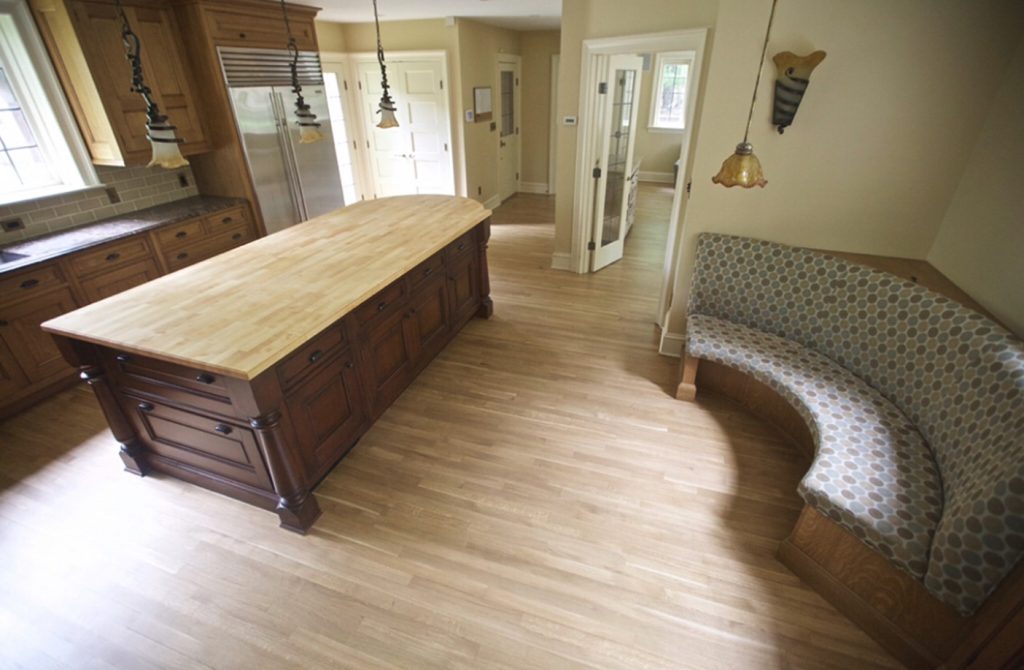
- 1. Traditional: Traditional-style interiors often feature warm, classic stain colors such as golden oak, honey, and amber tones. These create a timeless and cozy atmosphere that pairs well with antique furniture and decorative moldings.
- 2. Modern and Contemporary: For a modern and contemporary look, dark walnut, espresso, or gray stains are popular choices. These stains provide a sleek, upscale appearance and pair nicely with clean lines, minimalist furniture, and monochromatic color schemes.
- 3. Rustic: Rustic interiors frequently incorporate more natural red oak and golden oak stains that enhance the wood’s natural character. These stains create a welcoming, lived-in feel, and they complement exposed beams and vintage decor.
- 4. Beach and Coastal: Gray, driftwood, whitewash, and pickled stains evoke a coastal, beachy aesthetic. These stains create a light and airy ambiance that complements seaside-inspired decor and a palette of whites and blues.
- 5. Scandinavian: The Scandinavian design style often utilizes whitewash and pickled stains to achieve a bright, minimalist, and clutter-free environment. These stains make spaces feel larger and more open.
- 6. Vintage and Shabby-Chic: Whitewash, pickled, and custom mixed stains are favored for achieving a vintage, shabby-chic look. They create a sense of nostalgia and charm and work well with distressed furniture and floral patterns.
- 7. Transitional: For those who prefer a blend of traditional and contemporary styles, honey and amber tones offer a balanced approach. They provide warmth and versatility while complementing a mix of classic and modern furniture.
- 8. Eclectic: Homeowners who appreciate diversity often opt for custom stains and a mix of styles. This allows for the incorporation of various stain colors and design elements to create an eclectic and personalized interior.
Primary Tools for hardwood floor refinishing
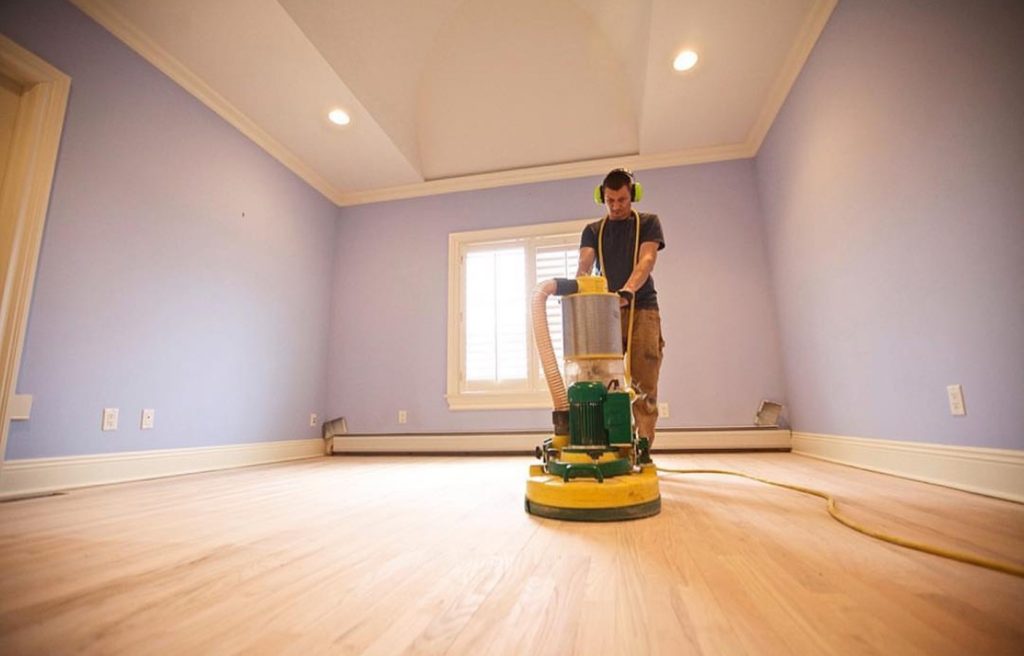
- 1. Drum Sander: The drum floor sander is the workhorse of wood floor refinishing. This heavy sanding drum machine uses a rotating drum covered with sandpaper to strip off the existing finish and level the wood surface.
- 2. Edger: A floor edger is a smaller, hand-held machine that is similar in function to an edge sander but more powerful. Hardwood floor edger used to blend the edges and corners sanded with the edge sander.
- 3. Detail Sander (Palm Sander): For intricate or small areas, a detail sander with a triangular sanding head is handy. It allows you to access tight corners and crevices.
- 4. Floor Buffer/Polisher: After sanding, a floor buffer or polisher equipped with a fine-grit sanding screen is used for the initial buffing and smoothing of the wood. This machine is also used to screen between coats of finish.
- 5. Floor Scraper: For removing stubborn adhesives or other materials from the floor, flooring scraper with a sharp blade can be effective.
- 6. Shop Vacuum: A high-quality shop vacuum is essential for collecting dust during the sanding process.
- 7. Hydraulic Flooring Nailer: If you’re replacing damaged boards, a hydraulic flooring nailer can be used to secure the new boards to the subfloor with precision.
Main Polyurethane Options
1. Water based polyurethane
Water-based polyurethane is a popular wood finish known for its durability, versatility, and environmental friendliness.
Composed of synthetic resins and water, it offers a protective coating that enhances the natural beauty of wood
surfaces. Unlike oil-based counterparts, water-based polyurethane dries clear and does not impart an amber tint, making
it ideal for maintaining the wood’s natural color and grain. It is available in various sheen levels, including matte,
satin, semi-gloss, and high-gloss, allowing for customizable finishes. Water-based polyurethane dries relatively
quickly, with a shorter waiting time between coats, minimizing project duration. Moreover, it is low in odor and
contains fewer volatile organic compounds (VOCs), resulting in a more environmentally friendly and user-friendly
application process. Cleanup is straightforward, as it can be accomplished with water, and it is less likely to yellow
over time compared to oil-based alternatives. Water-based polyurethane is an excellent choice for those seeking a clear,
durable finish that is also eco-conscious, quick-drying, and user-friendly.
- Appearance: Water-based polyurethane dries clear and is available in various sheen levels,
including matte, satin, semi-gloss, and high-gloss. It offers a more natural appearance,
allowing the wood’s natural color and grain to show through. - Durability: Water-based polyurethane is highly durable, making it a suitable choice for
high-traffic areas. It resists wear, UV damage, and moisture well. It also doesn’t yellow over
time, maintaining its clarity. - Drying Time: Water-based polyurethane has a faster drying time compared to oil-based
polyurethane. It typically dries within a few hours, allowing for quicker recoating and
minimizing downtime - Low Odor and VOCs: Water-based polyurethane emits fewer volatile organic compounds (VOCs) and
has a milder odor, making it a more environmentally friendly and user-friendly choice - Easy Cleanup: Cleanup is straightforward with water-based polyurethane. Water can be used for
cleaning tools and equipment
2. Oil based polyurethane
Oil-based polyurethane is a widely used wood finish known for its exceptional durability and warm, amber-tinted
appearance. Composed of synthetic resins and natural oils, it forms a protective coating that guards wood surfaces
against wear, moisture, and UV damage, making it a favored choice for high-traffic areas. Available in varying sheen
levels, including matte, satin, semi-gloss, and high-gloss, it offers flexibility in achieving the desired level of
shine. Despite its excellent protective qualities, oil-based polyurethane does have its considerations. It requires
longer drying times between coats compared to water-based alternatives, often necessitating overnight drying periods.
The application process requires attention to detail, as it can reveal brush strokes if not applied evenly.
Additionally, during application, it emits a strong odor and contains higher levels of volatile organic compounds
(VOCs), making proper ventilation essential. Nonetheless, its classic appeal and robust performance have solidified its
place as a traditional and enduring choice for wood finishing applications.
- Appearance: Oil-based polyurethane imparts a warm, amber hue to the wood, enhancing its color and grain.
It is available in matte, satin, semi-gloss, and high-gloss finishes. - Durability: Oil-based polyurethane is known for its exceptional durability. It provides excellent
resistance to wear, moisture, and UV damage. - Drying Time: Oil-based polyurethane has a longer drying time compared to its water-based counterpart. It
typically requires overnight drying between coats. - Strong Odor and VOCs: Oil-based polyurethane has a strong odor and contains higher levels of VOCs.
Adequate ventilation and caution are necessary when working with this finish.
Rubio Monocoat
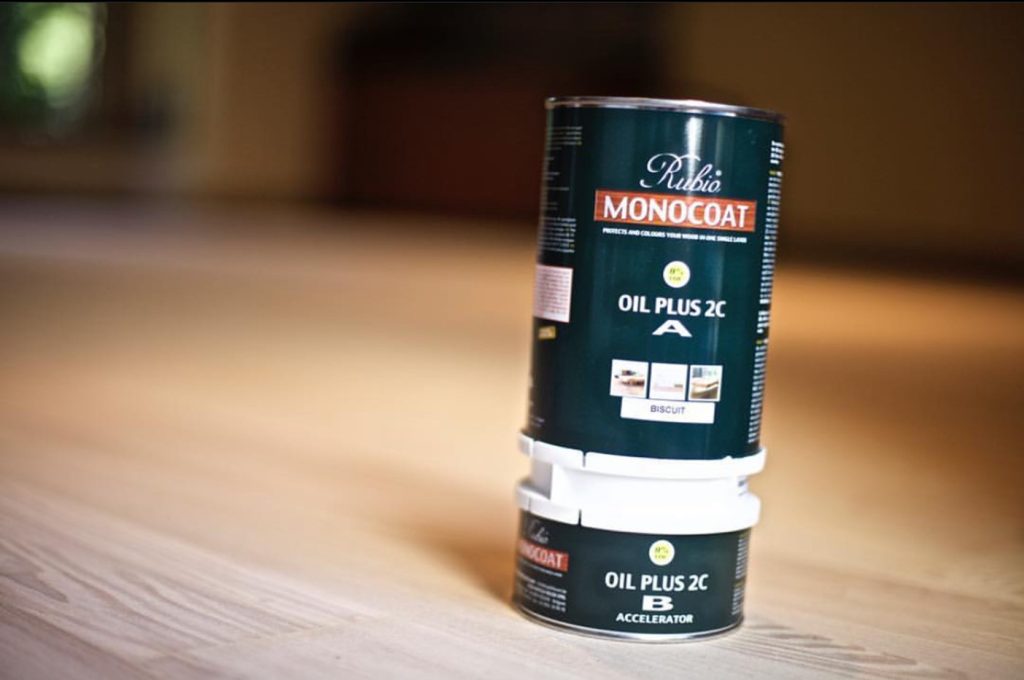
Rubio Monocoat is a unique and innovative finishing product gaining popularity for refinishing hardwood floors. This eco-friendly, single-coat system offers distinct advantages that set it apart from traditional finishes.
Rubio Monocoat is a plant-based, hardwax oil wood finish that’s designed to protect and enhance the natural beauty of wood surfaces. Unlike traditional polyurethane finishes, which build up in multiple coats, Rubio Monocoat achieves its protective qualities in a single coat. This single-coat system is renowned for its sustainability, ease of application, and durability.
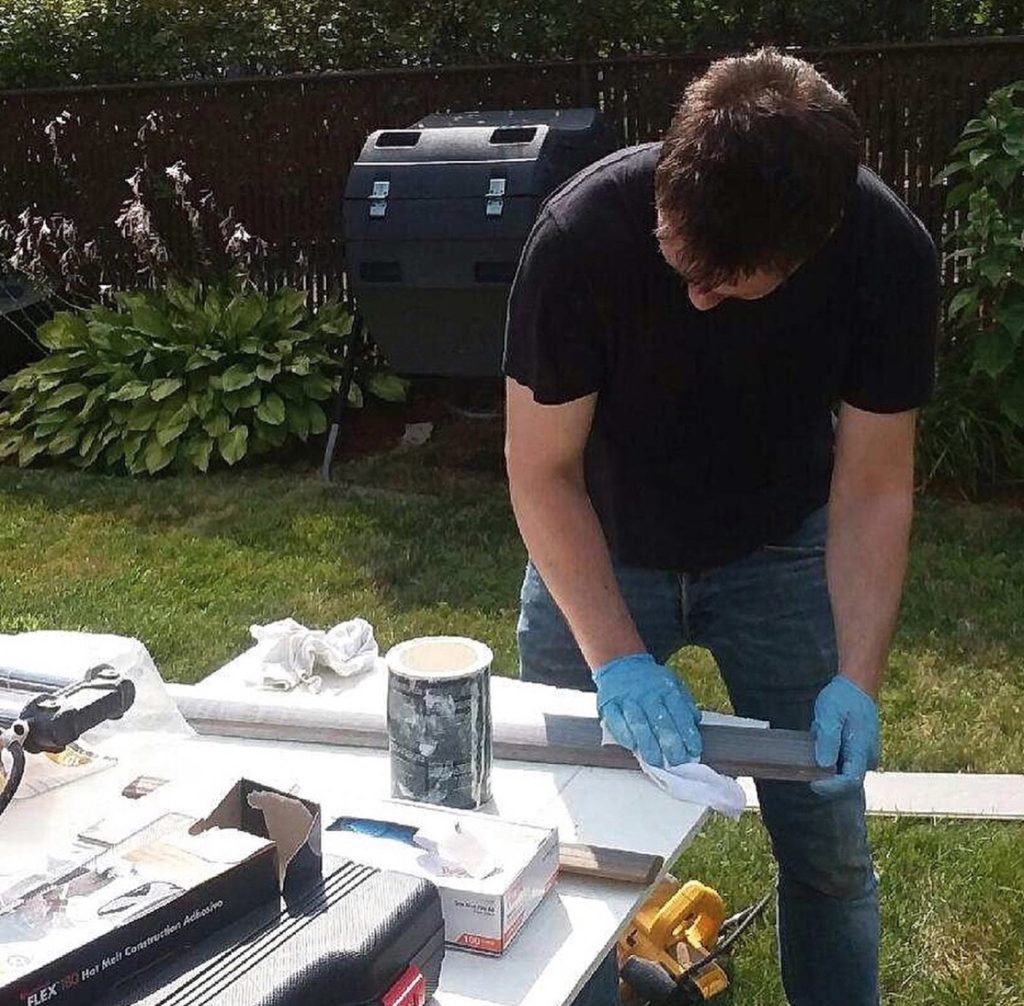
Key Features and Benefits:
- Single Coat Application: As the name suggests, Rubio Monocoat finishes wood floors in a single coat, saving time and effort compared to the multiple coats needed with traditional finishes.
- Environmentally Friendly: Rubio Monocoat is made from renewable, natural ingredients, including linseed oil and carnauba wax. It’s VOC (Volatile Organic Compounds) and solvent-free, making it an eco-conscious choice.
- Minimal Odor: Unlike some traditional finishes that can produce strong odors during application, Rubio Monocoathas a mild, natural scent and is more pleasant to work with.
- Natural Appearance: Rubio Monocoat enhances the natural color and grain of the wood without yellowing over time. It provides a matte, low-sheen finish that’s appreciated for its organic look.
- Durable Protection: Despite the single-coat application, Rubio Monocoat offers robust protection against wear, moisture, and UV rays. The molecular bonding ensures a long-lasting finish.
- Repairable: If the floor becomes damaged or shows signs of wear over time, Rubio Monocoat allows for local spot repairs. You can reapply the finish to the affected area without the need to refinish the entire floor.
- Wide Color Range: Rubio Monocoat comes in various colors, allowing for customization and personalization to match your preferred wood floor appearance. You can also mix colors to achieve a unique look.
Managing Dust
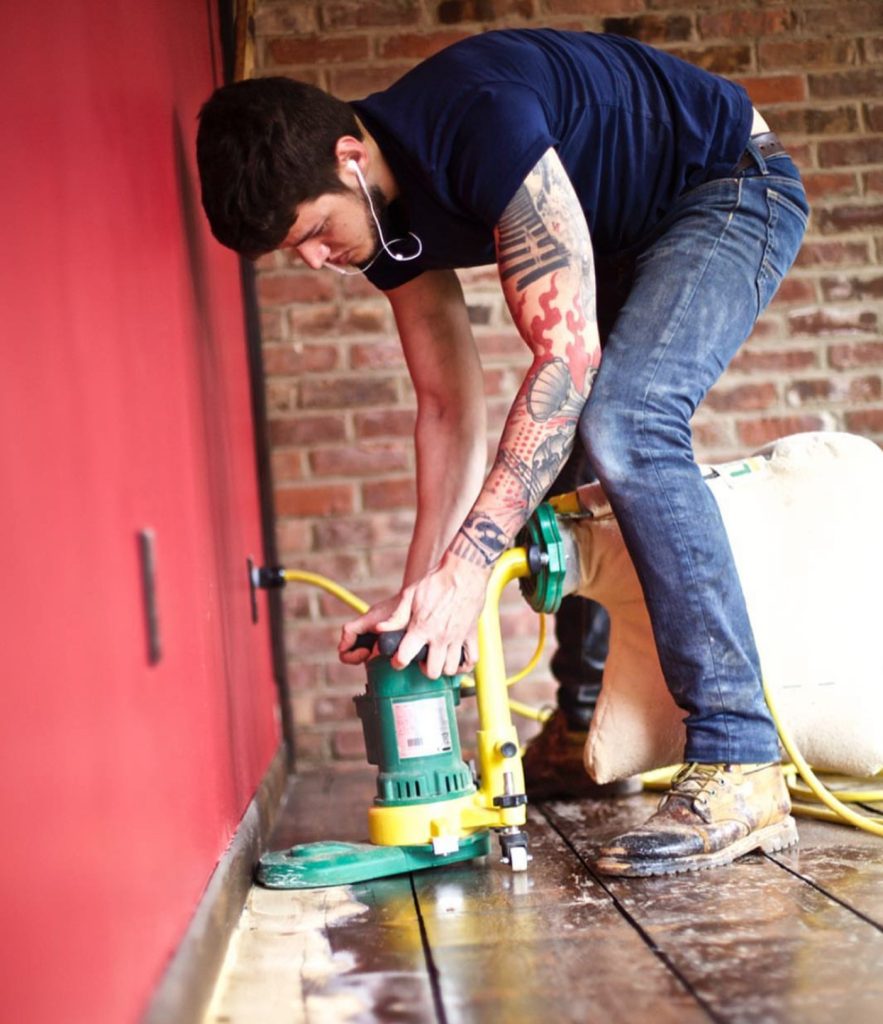
The key to a dustless sanding process is the use of advanced dust containment systems. These systems are integrated into the dustless sanding machine to capture, filter, and contain the dust generated during the sanding process. Some of the primary components of these systems include:
- Vacuum Systems: Dustless sanders are equipped with powerful vacuum systems that create strong suction to capture dust directly at the source. These systems pull in the dust, preventing it from becoming airborne.
- HEPA Filtration: High-Efficiency Particulate Air (HEPA) filters are used to trap and retain microscopic dust particles, ensuring that the air released back into the environment is free of harmful particulates. HEPA filters are essential for maintaining good indoor air quality and preventing respiratory issues.
2.Proper Setup and Preparation:
Before beginning the dustless sanding process, it’s crucial to properly prepare the workspace:
- Sealing Off Adjacent Areas: Dust containment sheets and plastic barriers are used to seal off adjacent rooms and areas to prevent dust from spreading.
- Covering Vents and Openings: Floor vents, HVAC vents, and openings in the room are covered to prevent dust from infiltrating the heating and cooling systems.
- Turning Off HVAC Systems: The HVAC system is shut off to prevent the circulation of dust-laden air.
- Clearing the Area: Furniture and other items are removed from the room, creating a clear and open space for the sanding process.
3.Dustless Sanding Machines:
Dustless sanding machines, including orbital sanders, edgers, and buffers, are equipped with integrated vacuum systems and HEPA filtration. These machines are designed to efficiently capture dust at the source while effectively sanding the wood floor.
- Orbital Sander: Orbital sanders with dust containment systems are ideal for the main sanding process. They use abrasive discs and, due to their random orbit motion, provide a smoother finish while collecting dust.
- Edge Sander: Edge sanders are used to sand the areas near walls and corners. The integrated vacuum system ensures that dust is captured as it’s generated.
- Buffer: Buffing machines with dust containment features are used to polish the wood floor and prepare it for finishing. The dust is immediately collected during this stage as well.
4.Sanding Progression:
The sanding process typically involves multiple passes with different grits of sandpaper. Starting with coarser grits to remove the existing finish and level the wood, the process progresses to finer grits for a smoother finish. The dustless sanding system collects dust throughout this entire process, leaving the air clean and the workspace significantly less messy.
5.Post-Sanding Cleanup:
Once the sanding is complete, the dust containment system continues to work during the cleanup phase:
- Vacuuming: A high-quality shop vacuum with HEPA filtration is used to clean the floor and surrounding areas. This further reduces any residual dust
- Tack Cloths: Tack cloths, sticky pieces of cheesecloth, are used to wipe the floor to pick up any remaining dust particles.
- Unsealing and Clean-Up: The barriers, plastic sheets, and coverings are carefully removed, ensuring that any trapped dust is contained for proper disposal.
6.Finish Application:
With a clean, dust-free surface, you can apply the finish. Whether you choose a water-based or oil-based finish, the dustless process ensures that the final result is smooth, blemish-free, and free of dust particles that can mar the finish.
7.Health and Environmental Benefits:
The dustless sanding process offers several health and environmental benefits:
- Improved Indoor Air Quality: By capturing dust at the source and using HEPA filtration, the process significantly reduces the release of harmful airborne particles, promoting healthier indoor air quality.
- Minimized Allergen Exposure: Dustless sanding is especially beneficial for individuals with allergies and respiratory sensitivities, as it reduces exposure to dust that can exacerbate these conditions.
- Environmentally Friendly: The containment of dust during the sanding process contributes to a cleaner and safer environment, as well as less post-project cleanup.


